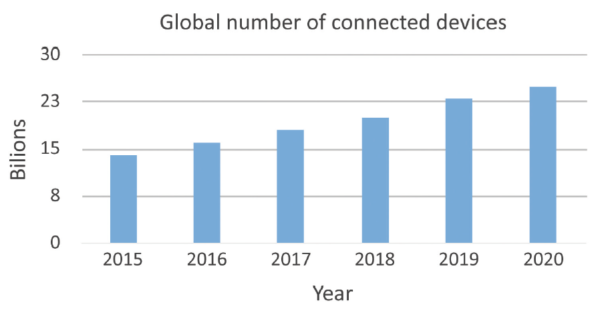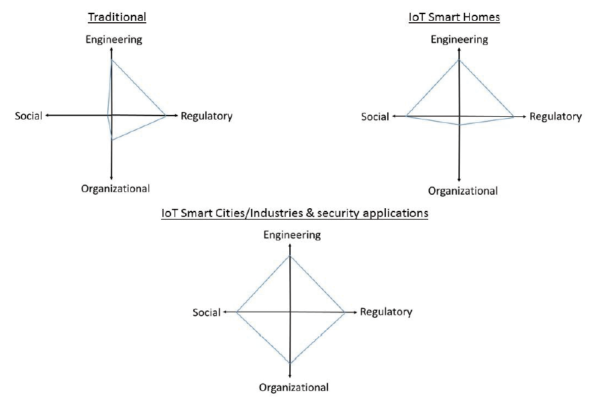The ongoing technical development towards the full vision of the Internet of Things will affect the area of EMC in the way that an increased consideration of social and organizational aspects will be needed in addition to the more or less traditional engineering approach that has characterized the EMC area up to now.
The term Internet of things (IoT) refers to the internetworking of physical devices, vehicles buildings and other items— embedded with electronics, software, sensors, actuators, and network connectivity that enable these objects to collect and exchange data. Kevin Ashton, one of the founders of the original Auto-ID Center, was the first to use “Internet of Things” in a wider sense in 1999.
The overall goal of Electromagnetic Compatibility (EMC) is the correct operation of different equipment in a common electromagnetic environment. The common way to achieve this goal is today typically solved by a pure technical engineering approach where standards, regulations and proven design criteria play a fundamental role. This approach may in most cases achieve EMC, at least for static cases and scenarios that do not change significantly over time. However, the more unpredictable scenarios we have, the more difficulties this static approach will experience.
The current development towards Internet of Things (IoT) where a massive increase of wireless technology via the 5G telecommunication development is foreseen, is expected to pave the way for the so called Networked Society. The Networked Society could therefore be seen as the realization of the full vison of the IoT. This development will highlight several new challenges for EMC. The vision of the Networked Society involves, in principle, all sectors of society. Examples are smart cities, e-health, smart homes, smart grids, smart agriculture, intelligent transport systems (ITS), logistics, industrial control, environmental monitoring, education, entertainment and media.
Forecasts of the growth of the number of connected devices are done continuously by different actors. A few years ago, forecasts were in the order 50 billion devices 2020, but those forecasts have now been considered as too optimistic. Fig. 1 shows a typical example of current forecasts. The largest growth in Fig. 1. is due to IoT-applications and the growth of PC/laptop/tablets and mobile phones is typically estimated only to a few percent from 2016 to 2020.

This development will create a complexity of co-location scenarios that has never been seen before. New electronic devices, both non-wireless and wireless will be co-located almost everywhere in the society and these scenarios will be highly random and dynamic, strongly affected by the habits of the consumers. Co-location scenarios will be largely driven by customer instant needs and social habits and will thus be characterized by being flexible, mobile and unpredictable. The challenge to achieve EMC in such an unpredictable environment will require new ways of thinking and planning in addition to traditional regulations and technical engineering. Social behavior and organizational issues will be of increased importance.
EMC by regulations, standards and technical engineering practice is state of the art but the involvement of social and organizational aspects requires new knowledge to be considered. With the on-going rapid increase of electronic products among consumers, all possible co-location scenarios cannot any longer be foreseen. Thus, the consumer behavior will play a more and more significant role whether or not EMC is achieved. Furthermore, even if we rely on standards, regulations and engineering practices, the human being can strongly affect the probability of achieving EMC.
For example, experience shows that even if detailed instructions for design, repair and maintenance exists, the final result is totally dependent on how the human being can/will handle these guidelines in a specific situation. A typical example is the installation of a new antenna at e.g. a platform or an antenna tower (where other antennas are already installed). If the technician for instance discovers that there is not enough space to fulfill the minimum co-location distance to the nearest metal structure, a decision must be taken on demand. Since the installation technician typically is not the EMC engineer, one possible approach is to mount the antenna where there is practical space. In such case, the final location of the antenna is solved as a pure mechanical problem, with the obvious risk that basic EMC-rules are violated. With a massive increase of wireless devices in most areas of the society, this problem will increase both due to more limited space for co-location and also unpredictable co-location situations.
Another example is maintenance or modifications involving shielded cables where the correct termination of the shields is highly crucial for achieving EMC. Unforeseen practical problems of doing this termination can result in complex EMC-problems, both to detect and solve. Thus, how people comply with different instructions and guidelines is of significant importance in EMC. Experience shows that the more complex situations, with lots of electronic equipment, different actors on the same site and a mix of wireless systems, the larger risk for EMC-problems as a result of difficult practical limitations for the technician. Furthermore, experience also shows that organizational matters can affect the possibilities of achieving EMC.
An environment where several actors provide their systems, the question of who has the overall integration responsibility with respect to EMC for the whole site is crucial. This is not always an easy problem to solve today. If there is not a clear decision of who is the overall EMC responsible, every single actor tries to solve their own EMC issues and the total EMC will not be of any of such actors concern. This problem increases with the complexity in the co-location site and the number of actors that have their systems installed at it.
One vision in the Networked Society is so called platooning of vehicles. By the use of wireless interconnecting technologies between vehicles, platoons that decrease the distances between cars or trucks can be formed. This capability would allow many cars or trucks to accelerate or brake simultaneously and the system would also allow for a closer headway between vehicles by eliminating reacting distance needed for human reaction. The EMC challenges for such scenarios may be highly complex and difficult to foresee since they are affected both by the local interference environment around and within single vehicles and the electromagnetic environment along the road. Furthermore, such wireless functions will be time critical with maximum allowed time delays (end-to-end) in the order of a few tens of milliseconds. Here, unsolved EMC problems can violate these time-delay requirements.
Antoher vision is e-health where one application is remote monitoring of patients in their homes by using wireless connected sensors. In such applications, the local electromagnetic environment in the patient´s home as well as the patient´s daily habits will have strong influence on the possibility of achieving EMC.
In summary, the vison of the Networked Society, driven by IoT and 5G will cause other than the traditional engineering aspects of EMC to grow in concern. Social and organizational aspects will play a significant larger role to achieve EMC in the complex co-location scenarios we will see in the future. In Fig.2 a schematic overview is shown for how the social and organizational aspects may grow compared to the engineering and regulatory aspects.

In smart homes, the social behavior may be almost as importance as the engineering and regulatory aspects. In other applications such as smart cities, industries and security applications, both the social and organizational aspects may be of equal importance. The development towards the Networked Society will probably cause the most complex challenges for the EMC area so far. Actors that recognize these challenges in an early stage and taking preventing actions will therefore have an opportunity of avoiding unexpected EMC-problems and at the same time unforeseen costs.
Peter Stenumgaard EMC-editor, Electronic Environment


